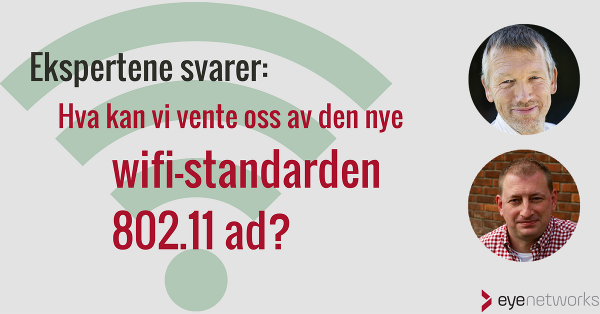What will the wireless standard 802.11ad mean for most users in the short and long term? Wi-Fi experts Josef Noll and Geir Arne Rimala respond.
Josef Noll responds
Wireless communication is in an exciting development. With new technologies for Wi-Fi we are looking at a huge increase in capacity. The new 802.11ad standard operates at 60 GHz, and aims for 4-6 Gbit/s, which is 20-60 times more data than we can achieve with today’s wifi.
A number of technological challenges remain, because communication works best with direct communication (line-of-sight, LOS), and all objects that get in the way can disrupt communication considerably. We envision that this type of communication will first come as a cable replacement for high-capacity video links, for example between a TV, set-top box and a router.
Geir Arne Rimala responds
802.11ad is the new standard that offers up to 7 Gbps and uses the unlicensed 60GHz band. The area of use for 802.11ad will probably be for HD/4k streams and devices that have to transfer very large files, for example video cameras that will transfer recordings, laptop backups and the like, in addition to normal use.
So let’s look more closely at the technology behind 802.11ad. The standard is still in its infancy, technologically speaking, compared to today’s standard 802.11ac.
- 802.11ac Wave2 uses four channels for 160MHz bandwidth, up to 256 QAM modulation, 8×8 spatial streams and not least MU-MIMO to offer approximately the same speed as 802.11ad.
- 802.11ad, on the other hand, uses only one spatial stream (1×1), one channel (out of a total of 4) and 64 QAM modulation to offer the equivalent.
When we get to the next phase of 802.11ad, with higher modulation, more spatial streams with MIMO, and the use of more channels, we are talking about very high speeds we can achieve. 802.11ad also comes with 16-32 antennas, which will probably provide a very precise beamforming which will later be useful for MU-MIMO.
What is both the advantage and the disadvantage of 802.11ad is the short wavelength (5mm), which limits the range to the same room and barely that. This means that the neighbor cannot interfere with your signal. The short wavelength also means that one can experience that a gadget on the other side of the room has a very good link, while another gadget that is less than one meter away will not have a link at all due to obstacles.
802.11ad can offer very high speeds over very short distances, but most people want better coverage and stability – not even faster speeds, so unfortunately there’s no magic silver bullet we’re getting here. But as an alternative to pulling a network cable along the living room wall, it is well positioned.
Meet the Experts
Professor Josef Noll, UiO

Josef is a specialist in wireless and mobile networks and security, employed by the Department of Informatics at the University of Oslo. Advocates for public Internet access as head of the Basic Internet Foundation . Also heads up the research project IoTSec-Security in IoT for Smart Grids.
Geir Arne Rimala, Eye Networks CTO

Geir Arne is an expert in IP networks, internet services, and Wi-Fi. He is also an experienced customer problem solver, pedagogically inclined and a popular course leader and speaker.
